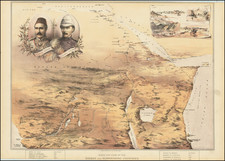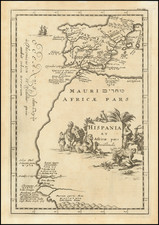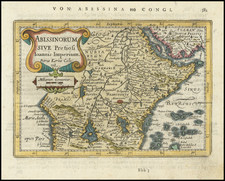Gordon of Khartoum Marches to Sudan.
Finely executed map, sketches, and detailed notes (and elevations in red) showing the Sudan Expedition of Charles George Gordon from Suakin to Khartoum, between February 28, 1874 and March 13, 1874.
The map and sketches were drawn by Charles George Gordon (his initials C.G.G. at bottom center), during his trip to Khartoum, following his appointment as Governor of the Sudanese Province of Equatoria. Gordon, a prolific writer, mapmaker, and sketch artist, references several maps and sketches that he created and sent back to various colleagues, as well as the Royal Geographical Society and Institute of Egypt, in his correspondence during his time as Governor between 1874 and 1876. In one such note, Gordon writes:
I have sent down to the Khedive a copy of the map of the Nile in duplicate, from Khartoum to this place [Gondokoro]; one copy being for the Geographical Society, the other for the Institute of Egypt. With the maps are also in duplicate other observations of heights, etc.
Details of the full journey are at the bottom center and read as follows:
- We left Cairo 21 Feby. arrived Suez 21 Feby.
- " Suez 22 Feby. " Suakin 26 Feby.
- " Suakin 28 Feby. " Berber 8 March
- " Berber 9 March " Kharoum 13 March
- The Vegetation of Bahr el Gazal [Southern Sudan] having been spread out in night to be at Gondokoro leaving Khartoum on 22 March about the 15 April
Text note reads:
The road from Suakin to Berber is through an arid mountainous country, as far as Ariab it is sparsely covered with dwarf trees of stunted growth, the wide plains are partly sand, and partly black basaltic stone from Goback to Berber the plain is generally sandy, the wells are mere holes scratched in the beds of rivers, ??? Nove.., ??? ??? fall but they are ???? ??? up. Price of Camel Hire from Suakin to Berber to Metemma 1 1/2 Nap[oleon]s. Hire of Boat from Berber to Khartoum 7 or 8 Nap[oleon]s. Nile rapids are dangerous to pass at night. Packages for Camels ought to weigh about 150 or 180 lbs. The climate is very dry, hot during day & cold at day break.
[Note: "Napoleons" are a reference to the gold coins used by traders and travelers in Sudan in this time period. For example, in 1880, the price of a slave in this part of the world was typically 10-20 Napoleons.]
A steady wind from North (stronger in the first part of the day) blows from the Month of Oct. till April after which it blows from the South from May till Sept.
Ns. The worst part of journey between Suakin & Berber is the latter day, the wells being so far apart.
The distance by road from Suakin to Berber about 288 miles by road. Sheep can be bought in Route. C.G.G.
Charles George Gordon
Charles George Gordon, born on January 28, 1833, in Woolwich, London, was a British Army officer and administrator whose tenure in Sudan during the 19th century remains a significant, albeit complex, part of his legacy. Gordon's military career began with his joining the Royal Engineers in 1852, and he saw action in the Crimean War. His service in China during the Taiping Rebellion in the 1860s earned him considerable recognition, so much so that one of his nicknames was Chinese Gordon.
After China, Gordon was active in the upper Nile region of central and eastern Africa for most of the rest of his life. Gordon was a highly experienced and capable military commander, and he played an important role in exploring and mapping the region. Gordon first traveled to the upper Nile region in 1869, as part of an expedition led by Sir Samuel Baker. He was responsible for mapping and studying the region, and he made a number of important discoveries, including the location of the source of the Nile River.
Gordon returned to the upper Nile region in 1874, when he was appointed as the governor-general of the region. In this role, he played an important role in the exploration and mapping of the area, and he helped to establish a number of key settlements and trading posts in the region. He also helped to improve the transportation infrastructure in the area, and he worked to promote trade and commerce in the region.
Gordon was appointed as the Governor of the Equatorial Provinces of Sudan by the Khedive of Egypt, Isma'il Pasha. His journey from Suakin to Khartoum, beginning in February 1874, was undertaken to establish order in the region and address the prevalent slave trade. The route, challenging due to the arid Nubian Desert, was indicative of the difficult task ahead.
Gordon's efforts in Sudan were primarily focused on the suppression of the slave trade, a pervasive issue in the region. His measures, though earnest, met with resistance from local traders and posed significant challenges due to the entrenched nature of slavery in the local economy and culture. Besides combating slavery, Gordon aimed to implement administrative reforms to enhance governance. He worked on improving infrastructure, particularly communication and transport networks, to facilitate better administration and trade.
Gordon's approach to governance in Sudan was direct and often autocratic, reflecting his personal convictions and military background. Gordon began his journey from the region back to England in October 1876, but was recalled by Isma'il Pasha and thereafter assumed the post of Governor-General of the entire country, a post which he retained until 1879, primarily working on Abyssinian affairs and with the insurrection in Darfur. He would later return to Sudan in 1884 as Governor-General amidst the Mahdist uprising, with the task of overseeing the evacuation of Egyptian forces.
The mission of General Gordon in Sudan concluded with the Siege of Khartoum, spanning from 1884 to 1885. Tragically, Gordon was killed on January 26, 1885, mere days before the arrival of rescue forces, signaling the end of the siege.
Gordon's legacy in Sudan is marked by his strong stance against the slave trade and his attempts at administrative reforms. However, his methods and the long-term impact of his policies have been the subject of historical debate. His time in Sudan, characterized by both his humanitarian goals and the practical difficulties of their implementation, provides insight into the challenges of British colonial policy during that period.
George La Rue, The Capture of a Slave Caravan: The Incident at Asyut (Egypt) in 1880 African Economic History, No. 30 pp. 81-106 (2002).











![[ Morocco Coast -- Tangiers to El Beddouza ] Eijgentlijke vertooninge der westcuste van Barbarien, tusschen de Strate van Gibraltar ende de C: de Cantin, zampt aller Reeden Havenen ende Rivieren aldaer gelegen, en hoemen die bequamelijck sal besijlen](https://storage.googleapis.com/raremaps/img/small/62218.jpg)


![[Christian Conquest and Fortification of Djerba in 1560] Aviso Del Successo Del Arm'ata De Christiani che si truova in Barberia, & della presa del Gerbi diretta al. S. Comendator Cambiano dal S. Paulo de la gesia Comedator; et secretario del R.S. gran Mastro de la religion de Rodi, Molto Magnifico S. Miro.](https://storage.googleapis.com/raremaps/img/small/61878.jpg)

![(Angra, Madera, Azores, North Africa) De Cust van Barbaryen van out Mamora tot Capo Blanco [with] De Cust van Barbaryen van Capo Blanco Tot Capo de Geer [with] De Reede van Punte del Gada int Eylandt S. Michiels [with] De zuydhoec vant Eylandt Fayal [with] De Reede voor de Stadt Angra int eylandt Tercera [with] De Eylanden van Madera en Porto Santo](https://storage.googleapis.com/raremaps/img/small/83722.jpg)